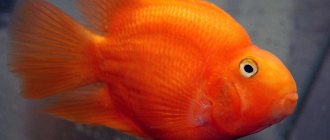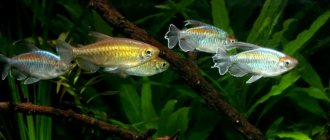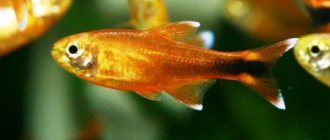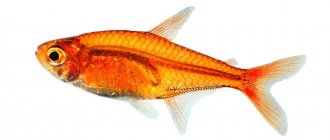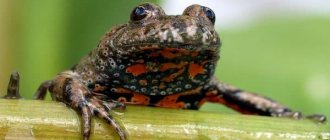Description of the fish
Rhodostomus has a small lean body up to 4.5 cm long. The color will not delight connoisseurs of bright exotics, but attracts with its calm charm.
The body of an adult specimen is greenish-silver, but it is impossible to call the fish faded without being dishonest, since there is a rather large red spot on its head.
The tetra's fins are transparent, and the tail is colored with alternating black and white stripes.
You can judge the comfort of a fish by the intensity of its color. If the conditions of detention are suitable for Rhodostomus, then the spot on the head will turn bright red. In stressful situations, a noticeable spot noticeably loses in intensity.
Diseases
The mobile and schooling aquarium fish Rhodostomus, with good care and caring attitude of the owner, rarely get sick, but there are exceptions. Most often, the tetra species is plagued by the following diseases:
- Fin rot - affects the fins of Rhodostomus, the cause of the disease is poor care. Treatment is carried out using streptocide or frequent water changes.
- Neon disease is an infectious disease that manifests itself in damage to internal organs and skin. Infected fish are destroyed.
Rhodostomus tetra is an agile schooling small fish that is easy to care for and maintain. Despite the demanding conditions for reproduction, miniature inhabitants of aquariums will be able to diversify the appearance of any artificial reservoir, demonstrating attractive colors and friendly character.
Aquarium fish: contents and compatibility
Although Rhodostomus does not require as much care as other colorful exotics, it is still considered the most fastidious among tetras.
So that the fish do not get sick and delight with their presence for a long time, they need to create suitable conditions for existence .
Aquarium volume, lighting and filling
Red-nosed tetras are gregarious creatures; to create a comfortable environment, you need to release from 7 to 15 individuals into the pond at the same time . Accordingly, the volume of the aquarium cannot be less than 50 liters.
The light should be chosen soft, diffused, since under natural conditions rhodostomuses live in shaded areas of reservoirs.
For filling, various ferns or erect algae are planted. It is a good idea to place a few driftwood to create natural hiding places for the flock.
Priming
Fine gravel or coarse river sand can be used as soil for the pond .
Important! Be sure to disinfect the soil before placing it in a pond.
To increase the reliability of the soil and bring the conditions closer to natural, it is a good idea to add dry leaves to the bottom.
Vegetation
Plants play an important role in creating suitable conditions for keeping Rhodostomus.
Fish in a stressful situation prefer to hide in thickets of algae, so you should not deprive red-nosed tetras of their natural shelter. Plant green spaces in sufficient quantities.
Water
To maintain rhodostomuses, soft and acidified clean water is required . Therefore, special attention must be paid to the serviceability of the filters and regularly (at least once every 7 days) replacing up to a quarter of the aquarium’s volume with fresh water.
The optimal temperature for keeping fish is 22…26 °C.
Feeding
Red-nosed tetras are not too picky when it comes to food. They willingly eat:
- dry food (both granulated and flakes);
- live food (prefer artemia or bloodworms);
- frozen food (daphnia or larvae).
The percentage of dry food should be half that of live and frozen food.
Another important factor for proper feeding is the size of the feed . The particle sizes should be small enough so that the fish can easily grab them with their small mouths.
Who is better not to live with?
It is definitely not worth housing the peace-loving Rhodostomus with predatory aggressive fish. Such a neighborhood will lead to the extermination of the tetra population.
Best neighbors
The best aquarium neighbors for the red-nosed tetra will be equally calm and peaceful fish .
Many aquarists prefer to house Rhodostomus with other tetras, but cardinals or black neons will also be excellent neighbors for them.
Spreading
The fish lives in large and small rivers of South America. This is a huge expanse of water in the Amazonian lowland, which forms the core of the South American jungle. Rhodostomus is also found in the Orinoco and Rio Negro. It was here that the fish was first caught by Europeans in 1886. Already by the middle of the 20th century, closely related species were found in smaller rivers: the Rio Purus and Rio Madeira.
The natural habitat is soft, calm water, standing or with a weak current. There are not so many underwater plants there - they are prevented from developing by the shadow of the forest canopy hanging over the reservoirs. Because of this, there is a lot of rotting plant residues in the howl, which form an acidic environment.
The freshwater water of the Amazon rivers is called “black water” by landscapers, although in fact it is more of a pale light brown color with high transparency. Tannins and tannins give color and chemical properties.
There are many products from different manufacturers that allow you to get the “black water” effect, however, with good filtration in an established landscape, and even with tap water changes, the validity period will not be long. Aquarists of the old Soviet school continue to make a decoction of oak bark and alder cones for this purpose.
Reproduction
Getting offspring from red-nosed tetras is not an easy task even for an experienced aquarist . This is due to several factors:
- the difficulty of adequately determining the sex of fish right up to spawning;
- fry development is incredibly slow;
- In hard water, fertilization of eggs is impossible.
is very important to initially create the necessary conditions for keeping rhodostomuses . Thus, fish intended for reproduction should initially be kept in soft, acidic water.
High demands are also placed on the spawner. It should be perfectly clean (it is recommended to use a sterilizer before introducing fish into it to kill all possible bacteria and fungal spores), with soft, sour water.
The diet of future parents should mostly consist of live food. There is no point in saving on food: if the fish are malnourished, they will not produce offspring.
also plays an important role in obtaining offspring . Rhodostomus females prefer to attach eggs to plants with small foliage, and almost all such algae require bright light, which is contraindicated for red-nosed tetras.
Attention! For the spawner, the optimal vegetation will be Java moss or synthetic threads.
The spawning tank should be placed in a quiet, shaded place.
Considering that the development of small red-nosed tetras is slow, they are fed with crushed food for quite a long time . It is best to use boiled egg yolk.
Read about other fish for the aquarium:
Danio glofish - fluorescent fish for your aquarium
Endler's guppies: miniature beauties for beginner aquarists
Rasbora wedge-spotted - a peaceful little fish
Features of feeding
Rhodostomus is omnivorous and absolutely unpretentious in terms of food. Therefore, they consume both dry and live food with equal appetite. An excellent food option for these fish would be bloodworms, tubifex worms, and brine shrimp. Plant foods and supplements will help diversify your diet. To avoid such problems as gnawing on the leaves of green spaces, aquatic and surface crops growing in the aquarium, it is periodically recommended to offer the rhodostomus crushed pieces of fresh vegetables and fruits.
Rhodostomuses have a tendency to overeat, so they need to be fed no more than 2 times a day (in the morning and evening), and in small portions. The food must be eaten within 5 minutes. After this, any remaining food should be removed from the aquarium immediately. Dry food should be used rarely, unless absolutely necessary, as it negatively affects the well-being of rhodostomuses.
Similar species
All tetras have certain similarities. But fish such as the false red head (it is somewhat larger than the red-nosed tetra), as well as petitella and hemigrammus Blechera, .
Petitella can be distinguished by the presence of an extended black stripe along the body and a dirty tint to the scales, but it is unlikely that chemigrammus can be distinguished from rhodostomus at home.
Although the fish is friendly, and watching a school of silver is a pleasure, Rhodostomus is not the easiest fish to keep and is unlikely to be suitable for a novice aquarist.
Best neighbors
Rhodostomuses are characterized by “nervous” behavior. The fish reacts painfully to sudden sounds and movements. When under stress, it can become dull, lose its healthy shine, and even sink to the bottom. Therefore, aquarium neighbors should be extremely peaceful and calm. A “hodgepodge” of different species of Characinaceae, for example, neons, will feel good. Danios, thornets, cardinals are also suitable; among large ones, non-aggressive South American cichlids and discus.
Neons
Danio
Ternetia
Cardinals
Cichlids
Discus
The red-nosed tetra experiences the greatest stress when purchased and added to the aquarium. There are cases when purchased individuals turned completely white. Over time, acclimatization will occur and the color will return. But because of this, it is better to plant Rhodostomus in an empty aquarium without inhabitants, so that the latter cannot serve as an additional stress factor.
Interesting things about severums
— Producers (male and female) are able to secrete a special secretion from the epithelium on which the juveniles feed. Therefore, as a rule, there are no problems with raising severum juveniles. However, sometimes this may not happen due to the fish’s adaptation to aquarium life; parents are simply too lazy to feed their babies.
— Cichlazomas severum are capable of forming not only opposite-sex pairs, but also monogamous ones (two females). The eggs of such producers, accordingly, remain unfertilized.
All of the above is just the fruit of observing this type of aquarium fish and collecting various information from owners and breeders. We would like to share with visitors not only information, but also live emotions that allow us to understand the world of aquariums more fully and subtly. Register at https://fanfishka.ru/forum/, participate in discussions on the forum, create profile topics where you will talk about your pets in the first person and from the horse’s mouth, describe their habits, behavior and content, and share with us your successes and joys, share your experiences and learn from the experiences of others. We are interested in every bit of your experience, every second of your joy, every awareness of a mistake, which makes it possible for your comrades to avoid the same mistake. The more of us there are, the more pure and transparent drops of goodness there are in the life and everyday life of our seven billion society.
Diet of the red-nosed tetra
Representatives of this species are omnivores with a preference for small live and flake food. To maintain excellent health, it is recommended to feed the red-nosed tetra daily with high-quality flake food. You can use brine shrimp (live or frozen) or worms as treats. This fish has a small mouth, so food must be of an appropriate size. It is recommended to feed Hemirammus Blecher several times a day.
Type: omnivore Flake food: yes Pelleted food: yes Live food (fish, shrimp, worms): small quantities Plant foods: small quantities Meat: small quantities Feeding frequency: several times a day
Diseases
If you plan to keep and breed rhodostomuses, it is worth noting that they, like other types of aquarium fish, are susceptible to diseases. It is important to remember that all diseases are directly related to poor living conditions. The most common disease is semolina. Small white dots appear on the fish's body. As a rule, Antipar is used for treatment; treatment is carried out according to the attached instructions.
Sources
- https://vplate.ru/akvariumnye-rybki/vidy/rodostomusy/
- https://fishcam-store.ru/rybki/rodostomusy-soderzhanie-i-uhod.html
- https://akvariumfish.ru/akvariumnye-rybki/tetra-rodostomus
- https://akvafan.ru/rybki/rodostomus
[collapse]
